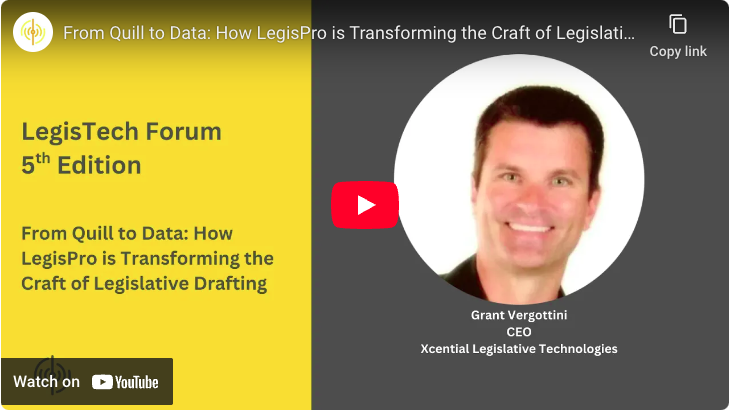Akoma Ntoso (LegalDocML) is now available for public review
May 12, 2015


It's been many years in the making, but the standardised version of Akoma Ntoso is now finally in public review. You can find the official announcement here. The public review started May 7th and will end on June 5th -- which is quite a short time for something so complex.I would like to encourage everything to take part in this review process, as short as it is. It's important that we get good coverage from around the world to ensure that any use cases we missed get due consideration. Instructions for how to comment can be found here.Akoma Ntoso is a complex standard and it has many parts. If you're new to Akoma Ntoso, it will probably be quite overwhelmed. To try and cut through that complexity, I'm going to try and give a bit of an overview of what the documentation covers, and what to be looking for.There are four primary documents
- Akoma Ntoso Version 1.0 Part 1: XML Vocabulary -- This document is the best place to start. It's an overview of Akoma Ntoso and describes what all the pieces are and how they fit together.
- Akoma Ntoso Version 1.0 Part 2: Specifications -- This is the reference material. When you want to know something specific about an Akoma Ntoso XML element or attribute, this is the document to go to. In contains very detailed information derived from the schema itself. Also included with this is the XML schema (or DTD if you're still inclined to use DTDs). and a good set of examples from around the world.
- Akoma Ntoso Naming Convention Version 1.0. This document describes two very interrelated and important aspects of the proposed standard -- how identifitiers are assigned to elements and how IRI-based (or URI-based) references are formed. There is a lot of complexity in this topic and it was the subject to numerous meetings and an interesting debate at the Coco Loco restaurant in Ravenna, Italy, one evening while being eaten by mosquitoes.
- Akoma Ntoso Media Type Version 1.0 -- This fourth document describes a proposed new media type that will be used when transmitting Akoma Ntoso documents.
This is a lot of information to read and digest in a very short amount of time. In my opinion, the best way to try and evaluate Akoma Ntoso's applicability to your jurisdiction is as follows:
- First, look at the basic set of tags used to define the document hierarchy. Is this set of tags adequate. Keep in mind that the terminology might not always perfectly align with your terminology. We had to find a neutral terminology that would allow us to define a super-set of the concepts found throughout the world.
- If you do find that specific elements you need are missing, consider whether or not that concept is perhaps specific to your jurisdiction. If that is the case, take a look at the basic Akoma Ntoso building blocks that are provided. While we tried to provide a comprehensive set of elements and attributes, there are many situations which are simply too esoteric to justify the additional tag bloat in the basic standard. Can the building blocks be used to model those concepts?
- Take a look at the identifiers and the referencing specification. These parts are intended to work together to allow you to identifier and access any provision in an Akoma Ntoso document. Are all your possible needs met with this? Implicit in this design is a resolver architecture -- a component that parses IRI references (think of them as URLs) and maps to specific provisions. Is this approach workable?
- Take a look at the basic metadata requirements. Akoma Ntoso has a sophisticated metadata methodology behind it and this involves quite a bit of indirection at times. Understand what the basic metadata needs are and how you would model your jurisdictions metadata using this.
- Finally, if you have time, take a look at the more advanced aspects of Akoma Ntoso. Consider how information related to the documents lifecycle and workflow might be modeled within the metadata. Consider your change management needs and whether or not the change management capabilities of Akoma Ntoso could be adapted to fit. If you work with complex composite documents, take a look at the mechanisms Akoma Ntoso provides to assemble composite documents.
Yes, there is a lot to digest in just a few weeks. Please provide whatever feedback you can.We're also now in the planning stages for a US LEX Summer School. If you've followed my blog over the years, you'll know that I am a huge fan of the LEX Summer School in Ravenna, Italy -- I've been every year for the past five years. This year, Kirsten Gullikson and I convinced Monica and Fabio to bring the Summer School to Washington D.C. as well. The summer school will be held the last week of July 2015 at George Mason University. The class size will be limited to just 30, so be sure to register early once registration opens. If you want to hear me rattle on at length about this subject, this is the place to go -- I'll be one of the teachers. The Summer School will conclude with a one day Akoma Ntoso Conference on the Saturday. We'll be looking for papers. I'll send out a blog with additional information as soon as it's finalized.You may have noticed that I've been blogging a lot less lately. Well, that's because I've been heads down for quite some time. We'll soon be in a position to announce our first full Akoma Ntoso product. It's an all new web-based XML editor that builds on our experiences with the HTML5 based AKN/Editor (LegisPro Web) that we built before.This editor is composed of four main parts.
- First, there is a full XML editing component that works with pure XML -- allowing it to be quite scalable and very XML precise. It implements complex track changes capabilities along with full redo/undo. I'm quite thrilled how it has turned out. I've battled for years with XMetaL's limitations and this was my opportunity to properly engineer a modern XML editor.
- Second, there is a sophisticated resolver technology which acts as the middleware, implementing the URI scheme I mentioned earlier -- and interfacing with local and remote document resources. All local document resources are managed within an eXist-db repository.
- Third, there is the Akoma Ntoso model. The XML editing component is quite schema/model independent. This allows it to be used with a wide variety of structured documents. The Akoma Ntoso model adapts the editor for use with Akoma Ntoso documents.
- And finally, there is a very componentised application which ties all the pieces together. This application is written as an AngularJS-based single page application (SPA). In an upcoming blog I'll detail the trials and tribulations of learning AngularJS. While learning AngularJS has left me thinking I'm quite stupid at times, the goal has been to build an application that can easily be extended to fit a wide variety of structured editing needs. It's important that all the pieces be defined as modules that can either be swapped out for bespoke implementations or complemented with additional capabilities.
Our current aim is to have the beta version of this new editor available in time for the Summer School and Akoma Ntoso conference -- so I'll be very heads down through most of the summer.








